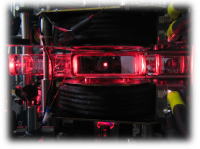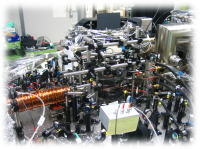


・Efimov trimers
Phys. Rev. Lett. 105, 023201 (2010).
Phys. Rev. Lett. 106, 143201 (2011).
The binding energy of an Efimov trimer state was precisely determined via radio-frequency association.
It is found that the measurement results shift significantly with temperature, but that the shift becomes
negligible at the lowest temperature in our experiment. The shift-free part of the trimer binding energy
reveals a significant deviation from the nonuniversal theory prediction based on a three-body parameter
with a monotonic binding-energy dependence.

・Thermodynamics of a unitary Fermi gas
Science 327, 442, (2010).
Thermodynamic properties of matter generally depend on the details of interactions between its
constituent parts. However, in a unitary Fermi gas where the scattering length diverges,
thermodynamics is determined through universal functions that depend only on the particle
density and temperature. By using only the general form of the equation of state and the
equation of force balance, we measured the local internal energy of the trapped gas as a
function of these parameters. Other universal functions, such as those corresponding to the
Helmholtz free energy, chemical potential, and entropy, were calculated through general
thermodynamic relations. The critical parameters were also determined at the superfluid
transition temperature. These results apply to all strongly interacting fermionic systems,
including neutron stars and nuclear matter.

・p-wave Feshbach molecules
Phys. Rev. Lett. 101, 100401 (2008).
We have observed p-wave Feshbach molecules for all three combinations of the two lowest hyperfine
spin states of 6Li. By creating a pure molecular sample in an optical trap, we measured the inelastic
collision rates of p-wave molecules. We have also measured the elastic collision rate from the
thermalization rate of a breathing mode which was excited spontaneously upon molecular formation.

・BEC critical temperature of fermion pairs near a Feshbach resonance
Phys. Rev. Lett. 101, 180406 (2008).
The critical temperature and the temperature dependence of the condensate
fraction for a fermion
pair condensate of 6Li atoms was measured. Bragg spectroscopy is employed
to
determine the critical temperature and the condensate fraction after a fast magnetic field ramp to the
molecular side of the Feshbach resonance. Our measurements reveal evidence of level off of the critical
temperature and limiting behavior of condensate fraction near the unitarity limit.
